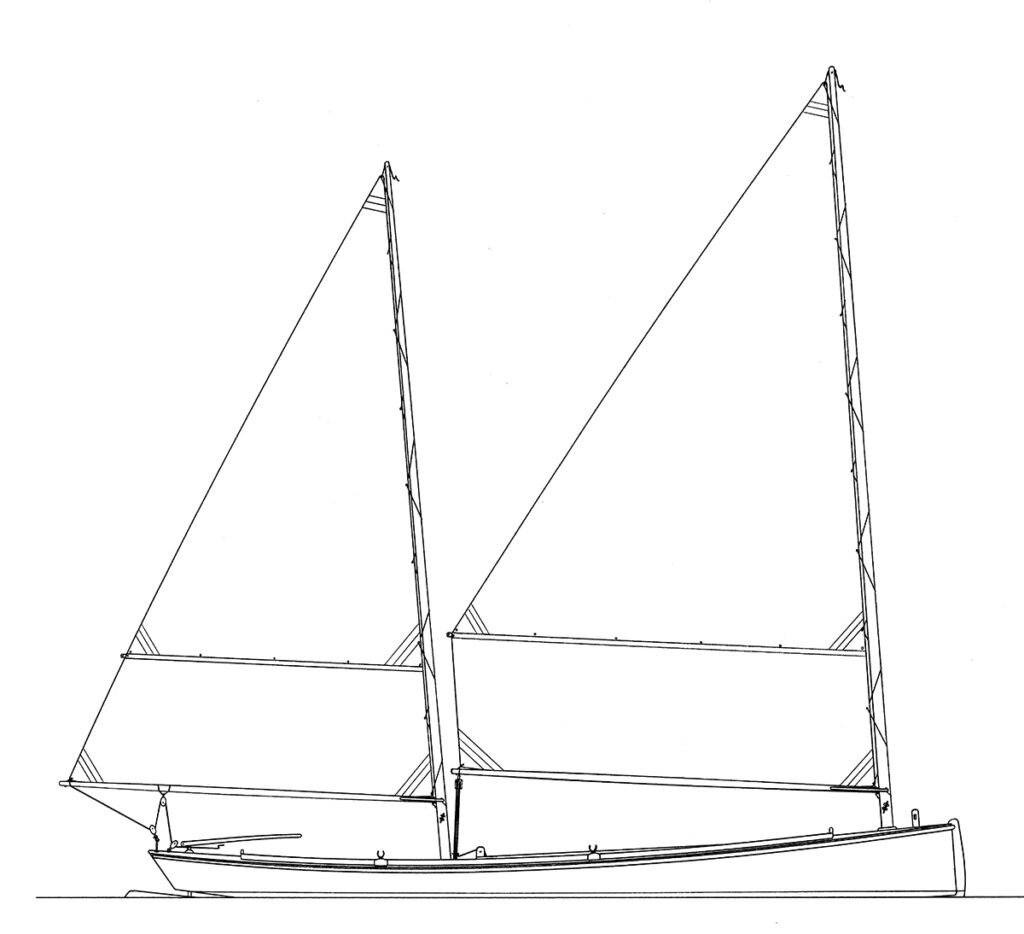
L.O.A.—21’ 10”
Beam—5’ 8”
Draft—11½”
Sail Area—263 sq ft
Weight—700#
I was first attracted to this design for the rig, which I have adapted and used on vessels over 50 feet (the Exuma 52’ Sarah) and under 20 feet (the 19-foot sharpie Gato Negro). Full-length battens are very useful devices in creating good sail shape, and have been known and used for millennia. In sharpies, the battens frequently consisted of two thin oak strips riveted or bolted through the sail, one on each side. Instead, I sew on reinforced batten pockets, and use PVC pipe for battens, with octagonal wood cores inserted inside the aft 60 per cent of the pipes to stiffen the after portion. I dip the pipe ends in boiling water for one minute or heat them with a heat gun and clamp 2×4 blocks on each side to flatten the ends. This allows the batten ends to fit snugly in the batten pocket ends, as well as allowing a long taper to be made at the forward batten ends to induce additional camber. I also duct tape the forward batten ends to prevent chafe. I drill 1/4-inch holes in the aft batten ends (which protrude from the leach 1 to 4 inches depending on boat size) for the tension lacings (battens must be placed under tension). Unless the sail has dramatic draft, the forward ends of the batten present no problem; they stay in line with the luff of the sail. One reason for this is the extreme flexibility of the PVC pipe—fiberglass battens won’t work.
The hull model for this boat—Fig. 45 from American Small Sailing Craft—is somewhat odd, and makes an interesting contrast to the other sharpies. It has rather a lot of beam forward, compensated by very shallow draft forward, and narrower beam aft by way of the after mast, with deep rocker at the same point. The stem rakes aft slightly, and the transom seems a little steep. In re-drawing the model for this book, I slightly altered the lines to balance these design elements more harmoniously, without eliminating them and the character they represent. Chapelle indicates that the model is somewhat crude, so I feel justified in altering it. In other aspects: beam, flare and sheer, I like the model and have not altered it. The figure from Chapelle is of a much larger boat (32 feet), and he states that the type was often smaller (18 to 22 feet). Since no drawings exist of the smaller, more common models, I can only speculate on what they were like; this drawing represents that speculation. It is also interesting to note that the lines were taken off a hulk at Cedar Keys, Florida, in 1928 by Larry Huntington, at the direction of Ralph Munroe!
Because the Cedar Keys sharpie has more beam and displacement than other similar sized sharpies, I feel this craft would make an excellent camp boat and family pocket cruiser for her size, yet will also perform very well, being stiffer than her peers and faster off the wind.
